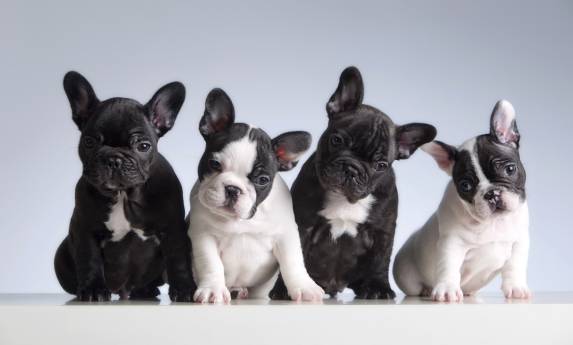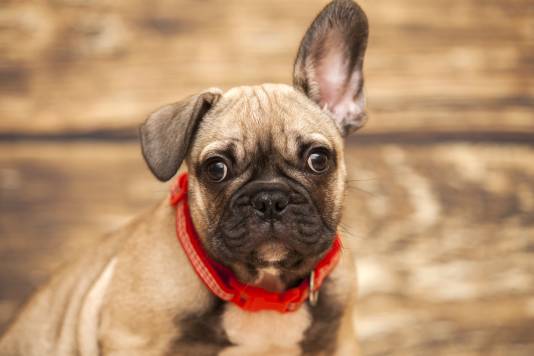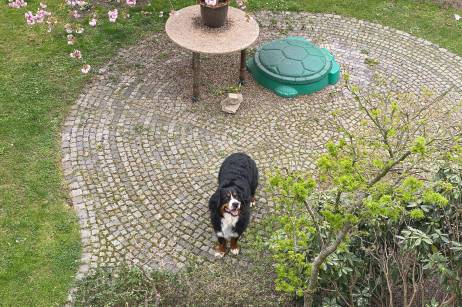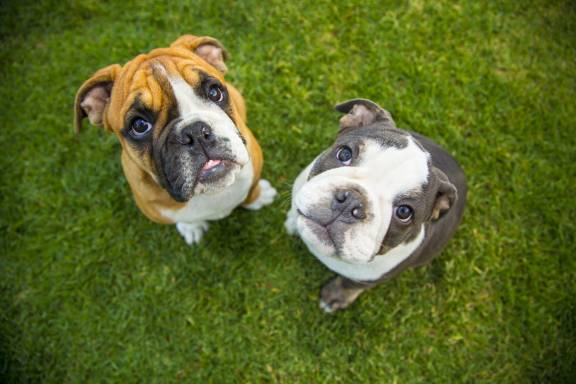Connect with a verified veterinarian in minutes. Licensed vets are available 24/7 to answer your questions. No need to worry about your furry family member.
Have you ever wondered about how many types of French Bulldogs there are? Would you like to learn more about these adorable small dogs? If so, you’re in the right place!
We’ve put together some information about French Bulldogs and the different types of French Bulldogs you may find! Let’s get started!
What is a French Bulldog?
French Bulldogs are small dogs that originally came from England. Why are they called “French?” Well, that comes a little bit later! The dogs were originally bred to be toy-sized bulldogs. They were popular with lace makers who lived in Nottingham. Thankfully, when they emigrated to France, the lacemakers took their French Bulldogs with them! It’s because the dogs were once from France that they are now known as French Bulldogs!
French Bulldogs (also known as Frenchies) are famous for their bat-ears and wrinkly faces. The small dogs are so cute; they really draw you in with their small bodies and adorable faces. The dogs can be quite clownish, too, and love to have a great time!
Frenchies are small but have a muscular, powerful bodies. They have an easy-to-care-for coat and a laidback personality. And these small dogs love to play! However, they also enjoy snuggling with you on the sofa.
These highly intelligent dogs enjoy training, as long as it’s fun! They do think on their own, which makes them not the best dog breed for training or dog sports. That’s because these little free-thinkers can also be quite stubborn. If a French Bulldog decides he doesn’t want to do something, there’s almost no way to coax him!
French Bulldogs are loving companions who need plenty of human attention. These dogs cannot be left out alone or unattended for long periods. They love their pet parents and want the same treatment in return. What’s more, they tend to get along with almost everyone and do well with kids. However, Frenchies can also be quite territorial and possessive of their family, especially if other dogs are around. So, French Bulldogs must be trained and socialized from puppyhood.
If you talk with a French Bulldog pet parent, they will tell you how clownish these dogs can be! They are funny and love to be mischievous.
Frenchies also make wonderful watchdogs and will let you know if strangers are coming near. They usually only bark when necessary, which is rare in a small dog. French Bulldogs are very protective of their homes and families and will defend to the death if necessary.
These small dogs can live comfortably in apartments and small houses. They need about two 15-minute walks a day, which is essential to keep the dogs from gaining weight. When it comes to their environment, French Bulldogs don’t do well in a warm, humid location. They need to be in the air conditioning at all times in this type of climate.
French Bulldogs stand between 11 to 12 inches tall and weigh between 16 to 28 lbs. They have a life expectancy of 11 to 14 years.
OK, with that background information about French Bulldogs, we’re now ready to learn about types of French Bulldogs!
French Bulldog Types
When we talk about French Bulldog types, we’re actually speaking about different French Bulldog colors. These dogs can have coats of various colors, with the most common colors being fawn, brindle, white, and pied. However, there are other color variations, too. Let’s take a look!
1. Fawn French Bulldog
Fawn Frenchies have a tan coat that can vary between light tan, golden tan, dark reddish tan, and cream. The dark reddish fawns are called red-fawns.
Fawn Frenchies have dark faces and ears. They also have a smooth coat with no brindle patterns. These dogs are adorable!
2. Brindle French Bulldog
The brindle French Bulldog has a dark coat with lighter strands of color. A brindle Frenchie usually has white on their head, chest, neck, and toes.
Then there’s the strong brindle French Bulldog. These dogs are a mix of colors, including tan and brown. Their coats look like an expensive Asian carpet! Brindle Frenchies can have different patterns in their fur, too.
3. Tiger Brindle French Bulldogs
Tiger brindle Frenchies are similar to the Brindle Frenchie; however, they have light hair with lines of black that make the dogs resemble a tiger!
4. Black Brindle French Bulldog
The black brindle French Bulldog may sound like an oxymoron! How can a black dog be brindle? Well, it’s entirely possible. Black brindle Frenchies are black, with a subtle brindle pattern.
These are the most popular French Bulldogs around!
5. Pied French Bulldog
Pied French Bulldogs are an off-white or eggshell color, with some dark patches. Most pied Frenchies have one patch around one eye, which marks them as very special dogs, indeed!
6. Seal Brindle French Bulldog
Seal brindle French Bulldogs have light hairs that are almost difficult to see. These dogs may look entirely black, but they actually have some white hair scattered over their bodies!
7. Brindle Pied French Bulldog
The brindle pied French Bulldog have white coats with some dark patches and colors scattered throughout their coat. Some of these dogs even have a dark shade around one eye and spots on their feet.
There are others who have multiple patches and others who have black around their face and back.
Brindle Pied Frenchies are quite pretty!
8. Blue/Grey French Bulldog
Next, we have the blue/grey French Bulldog. This is one of the rarest Frenchie colors. This dog’s colors are caused by dilute genes that turn the black to a blue-grey color pattern. It’s very pretty, we must say!
9. Cream French Bulldog
Cream French Bulldogs are diluted fawns with an off-white to eggshell-colored coat. They’re also very striking dogs!
10. Sable French Bulldog
The sable French Bulldog has a fawn coat with strings of dark hair. The hair becomes darker from the back to the front.
11. Blue Sable French Bulldog
The blue sable Frenchie also has a fawn coat that has strings of blue-tipped hairs on the back.
12. Lilac French Bulldog
The lilac French Bulldog is another rare color for this dog breed. Both parents must carry the blue and chocolate genes to have lilac puppies.
13. Chocolate French Bulldog
The chocolate French Bulldog is another rare color. Both parents must have the recessive chocolate gene, which is rare. Chocolate Frenchies usually have light eyes that come in gold, green or yellow.
14. Isabella French Bulldog
The Isabella French Bulldog is the rarest color in Frenchies. These dogs are developed by breeding parents that carry the DD genes. The result is puppies that have a pale purple color to their chocolate or blue coats.
The one downside of this coloring is that these dogs usually develop alopecia and other health conditions.

Review symptoms, medications & behavior to keep your pets healthy with a Vet Online in just minutes.
Ask a Vet Live NowWhat French Bulldog Colors are Not Accepted by the AKC?
The only official colors recognized by the AKC for Frenchies are white, cream, fawn, and variations of these colors. Markings are also allowed.
The AKC accepts these colors because they are the colors that were common when the breed standard was created. It’s true the dogs have always carried the other color variations; however, these were caused by recessive genes. As a result, those rare colors didn’t show up very often.
What’s the Most Expensive French Bulldog Color?
The most expensive Frenchie color is the Isabella. Isabella is also the rarest French Bulldog color and takes great effort and time to achieve. That’s because the color is only achieved through two copies of two rare genes. If a breeder wants to breed an Isabella puppy, it takes a lot of time and effort.
In addition, the dogs with this coloring are genetically tested. Breeders want to ensure the dogs have the two-color genes required for this coloring. It is possible for a dog to have this coloring without the genetic coding needed for the Isabella Frenchie. That can be a problem for show dogs, but not for dogs who will be pets.
What’s more, Isabella dogs are often bought by other dog breeders to create more Isabella dogs. This is another reason the dogs are so expensive. They’re often priced for breeders who make money from the puppies they’ll breed.
What is a Platinum French Bulldog?
The platinum French Bulldog is a cream Frenchie with a fancy name. That’s it! There’s no difference at all, but breeders try to earn extra for their dogs and so call the dogs different colors, marking the dogs as rare. However, that’s not the case. These are cream Frenchies!
So, if you find a “platinum” French Bulldog to adopt, don’t pay the high price that’s being asked by the breeder. This is really a cream French Bulldog that’s listed at a higher price than usual.
What’s the Best Color for a French Bulldog?
There’s no one color that’s best for a French Bulldog. Each color is precious, beautiful, and unique. It’s best to choose a dog that has a personality that fits you and your family, rather than buying a dog due to his color. That is unless you’re going to show the dog. If so, then you’ll want to choose a Frenchie in a color that’s accepted by the AKC.
In addition, it’s best to choose colors that are not associated with health issues. In Frenchies, these colors are usually produced by dilute and merle genes.
If you’re trying to find a Frenchie at a reasonable price, then it’s best to choose one of the more common colors for this dog breed. Keep in mind that French Bulldogs tend to cost more than other dog breeds. And it really doesn’t make sense to pay more for a “rare” color.
After all, no matter what color a French Bulldog is, he’s still a French Bulldog!
How to Care for a French Bulldog of Any Color
No matter what color your Frenchie is, you’ll be happy to learn they don’t require a lot of exercise. They are low-energy dogs, although you may come across the rare French Bulldog who has the energy to spare! Even so, Bulldogs have a tendency to gain weight, so exercise is imperative for these dogs.
Frenchies enjoy short walks, playing in the yard, and more. However, they are prone to heat exhaustion if they exercise too much in the heat and humidity. So, it’s best to take your fur baby out to walk in the early morning or late evening, when it’s cooler.
Feeding
French Bulldogs need about 1 to 1.5 cups of high-quality dry dog food each day. This can be divided into two separate meals during the day.
Grooming
Frenchies are easy to groom and only need brushing once in a while to keep their coat clean and shiny. These dogs do shed, so you may want to consider brushing them more often.
Because French Bulldogs are prone to skin problems, it’s always a good idea to check your dog’s skin when you brush him. Check for scabs, bare spots, rough/flaky patches, signs of infection, and more. It’s also a good idea to check your Frenchie’s eyes, ears, and teeth on a regular basis. If you spot anything that seems concerning, then do make an appointment with the vet.
In addition, Frenchie’s face wrinkles should be cleaned and dried regularly. These areas are prone to developing bacterial and fungal infections.
When it comes to bathing, French Bulldogs need a bath about once a month. Bathing too often removes the dog’s protective oils from his skin and fur.
Do Frenchies Get Along with Kids & Other Pets
French Bulldogs get along great with kids. However, it’s best to always supervise your dog and kids when they’re playing together. This is true of all dog breeds.
And if Frenchies have been trained and socialized from a young age, they can get along well with other dogs and cats. However, they do tend to be jealous of other dogs, especially if the dog is getting lots of attention from the French Bulldog’s favorite person!
Summing It Up
As you can see, there are many types of French Bulldogs! They come in a wide variety of colors. However, if you’re interested in adopting a family companion, then the dog’s color really doesn’t matter. Choose a Frenchie based on his personality and whether he’s the right dog for your family!
Connect with a verified veterinarian in minutes. Licensed vets are available 24/7 to answer your questions. No need to worry about your furry family member.

Julie
Julie is a graduate of the University of North Carolina, Wilmington, where she studied Animal science. Though contrary to the opinion of her parents she was meant to study pharmacy, but she was in love with animals especially cats. Julie currently works in an animal research institute (NGO) in California and loves spending quality time with her little cat. She has the passion for making research about animals, how they survive, their way of life among others and publishes it. Julie is also happily married with two kids.
Review symptoms, medications & behavior to keep your pets healthy with a Vet Online in just minutes.
Ask a Vet Live Now




